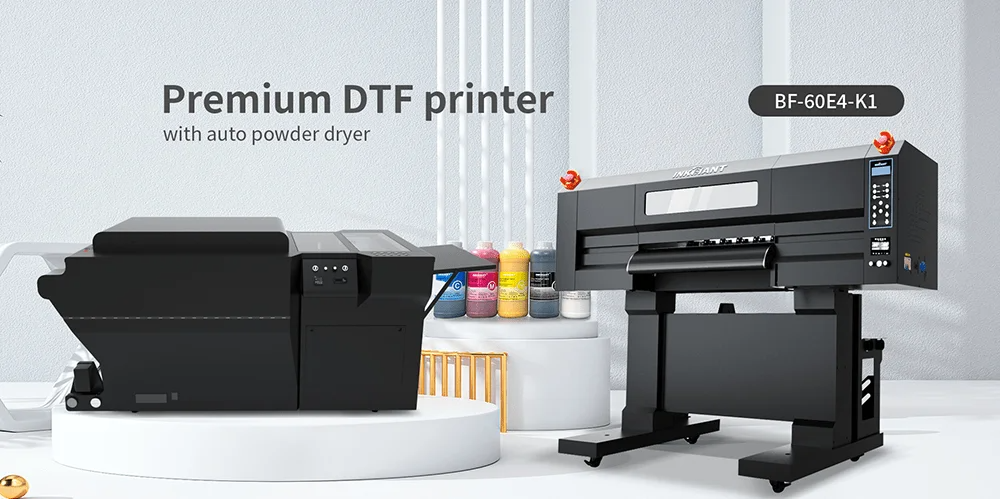Direct to Film printing is one of the most rapid game changing technologies to hit the textile and garment printing field. The fact that it produces very high quality, durable and vibrant prints on just about any type of fabric makes it a favorite amongst small and large businesses. Learning the full DTF printing process and steps is necessary for someone interested in this technology to produce professional results and work efficiently.
This guide will go into detail on the DTF printing process and why you should invest in the DTF printer for your success.
What is DTF Printing?
But before I get into the process, let’s first look at DTF printing meaning.
DTF printing, or Direct to Film, is a newer digital printing method where you print your design on a special PET film, apply an adhesive powder, and heat press it onto any fabric. On top of that DTF does not require pre-treatment of fabric like traditional screen printing or DTG Direct to Garment printing, and works exquisitely on cotton, polyester, blends, and even leather.
This flexibility and capability of application lend DTF to be a great choice for custom t-shirts, activewear, fashionwear as well as branded merchandise.
Step-by-Step Process of DTF Printing
Here is the detailed operation process of DTF printing from start to finish:
Design Creation and Preparation:
The first step is to design your art work with any graphic software program like Adobe Photoshop, Adobe Illustrator or CorelDRAW. To ensure best results, your design should be:
- Is high resolution 300 DPI.
- Employs vibrant colors to maximum effect.
- Is exported in your printer’s RIP software-compatible format.
Tip: Always set your file to CMYK mode so that the colors in print will look as you intended them to..
Printing the Design on PET Film:
Once your design is ready, it’s sent to the DTF printer.
- The printer first prints the colored layer of the design in reverse onto a special PET (Polyethylene Terephthalate) film.
- Next, it prints a white ink layer over the colored layer, creating a base for the adhesive powder to stic
Why the Printer Matters: Using a high-quality DTF printer ensures sharper details, better color vibrancy, and fewer printhead issues. LINKO printers, for example, are engineered to deliver professional-grade results consistently.
Applying Hot-Melt Adhesive Powder:
Immediately after printing, the wet ink on the PET film is coated with a hot-melt adhesive powder.
- Sprinkle the powder evenly across the printed area.
- Shake off any excess powder to prevent clumping during the curing stage.
Tip:Consistent and uniform application of powder is critical for ensuring strong adhesion of the design to the fabric.
Curing the Adhesive Powder:
After powder application, the film is cured to melt the adhesive:
- Place the film in a curing oven or hover it under a heat press (without pressing down).
- Set the temperature to around 160–170°C (320–338°F) for 2–3 minutes until the powder melts evenly and forms a smooth layer.
Result: A sticky, ready-to-transfer film that bonds perfectly during pressing.
Heat Transfer to Fabric:
Next, position the cured PET film onto the garment where you want the design to appear. Using a heat press:
- Temperature: 160–180°C (320–356°F)
- Time: 10–15 seconds
- Pressure: Medium to firm
This step transfers the design from the film to the fabric.
Pro Tip: Ensure the film is aligned correctly to avoid crooked prints.
Peeling the PET Film:
Once the pressing is done, allow the garment to cool slightly before peeling off the PET film.
- Cold Peel: Most DTF films require cooling before peeling to prevent smudging.
Result: A vibrant, long-lasting print with excellent elasticity and wash durability.
Post-Pressing (Optional but Recommended)
For added durability and to give the print a softer hand feel, post-press the garment with a Teflon sheet or parchment paper for 5 seconds.
Bonus: This step helps embed the design deeper into the fabric fibers and enhances its resistance to cracking or peeling.
Why Choose LINKO DTF Printers?
The efficiency and quality of your DTF printing process depend heavily on the printer you use. At dtflinko.com, you’ll find LINKO DTF printers designed to meet the demands of both small startups and large-scale production facilities.
Advantages of LINKO DTF Printers:
- High-Speed Printing: Ideal for bulk orders without compromising quality.
- Precision Engineering: Produces detailed, vibrant prints with minimal banding.
- Durability: Built for continuous operation with low maintenance needs.
- User-Friendly Operation: Perfect for businesses new to DTF technology.
Whether you’re launching a custom apparel brand or upgrading your existing production line, LINKO offers tailored solutions for every need.
Advantages of DTF Printing:
- Works on all fabric types (cotton, polyester, blends, leather, etc.).
- No pre-treatment needed, unlike DTG printing.
- Produces soft, stretchable, and durable prints.
- Cost-effective even for small print runs.
Final Thoughts:
DTF printing has transformed textile decoration by offering a fast, versatile, and cost-efficient way to produce high-quality prints. By mastering the complete operation process and steps of DTF printing, you can ensure professional results and a smooth workflow.
To get started, invest in a reliable DTF printer and explore comprehensive solutions at dtflinko.com to grow your printing business with confidence.

